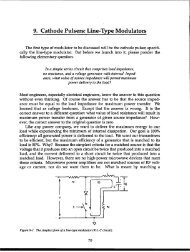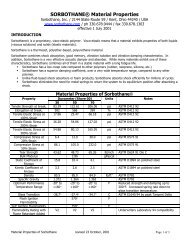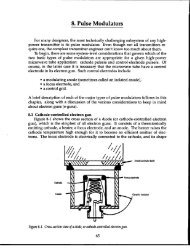3.6M north10.pdf - Dean-O's Toy Box
3.6M north10.pdf - Dean-O's Toy Box
3.6M north10.pdf - Dean-O's Toy Box
You also want an ePaper? Increase the reach of your titles
YUMPU automatically turns print PDFs into web optimized ePapers that Google loves.
Cathode Pulsers: Hard-Tube Modulators (10) 157<br />
voltage pulse in the latter case, the ramplike~ or droop, component would have to<br />
be subtracted from the output. To keep klystron voltage constant at 0.8V, the<br />
switch-tube anode voltage would vary from 0.2V at the beginning of the pulse to<br />
a theoretical minimum of zero (assuming no head-room requirement). The additional<br />
anode dissipation per pulse would be O.lV x 1, where O.lV is the timeaveraged<br />
anode drop and 1 was the load current, as before.<br />
This may have sounded like a good idea, but it wasn’t. Its fatal flaw was that<br />
it didn’t account for what happens under the major fault condition: simultaneous<br />
klystron and switch-tube arc-breakdown, or load shoot-through. The only<br />
good news was that the fault current was limited by the network characteristic<br />
impedance to 10 times 1, where I is the normal peak load current. Without series<br />
resistance, however, the network stored energy would tend to oscillate back and<br />
forth, completely reversing the voltage on the network capacitance periodically<br />
until the load arc was finally extinguished. To completely absorb network energy<br />
without capacitor-voltage reversal, a series resistance equal to ZO, or O.lR,<br />
was required between network and load. But this completely subverted the<br />
reason for the network in the first place. (This is but another example of having<br />
to design for the worst-case scenario rather than the hoped-for “normal” operating<br />
conditions.)<br />
Rarely if ever, are the capacitive energy-storage requirements of even a modest-sized<br />
transmitter met by a single capacitor (or “can,” as it is sometimes called).<br />
Multiple cans connected in parallel or series-parallel are the rule rather than the<br />
exception. The danger in multiple-capacitor arrays is what can happen if a single<br />
capacitor internally short circuits. If the total surge-current-limiting resistance is<br />
distributed throughout the array by having at least one resistor capable of dissipating<br />
the energy stored in a capacitor in series with each capacitor, a shortcircuit<br />
failure will cause no damage because virtually no energy will be dissipated<br />
in the faulted capacitor. Such an arrangement is so fault tolerant that the<br />
failed capacitor may not immediately reveal itself. (If the capacitors are all in<br />
parallel, the resistor in series with the failed capacitor will be connected across<br />
the dc power supply when an attempt is made to turn it on again. What is left of<br />
that resistor will usually bean adequate tell-tale sign for where the trouble lies.)<br />
Series-parallel connections are often employed when the system’s operating<br />
voltage is much above 50 kV. This is because energy storage density tends to<br />
degrade at much higher voltage, and more volumetrically efficient banks can be<br />
assembled from capacitors rated at less than 50 kV—by no means a hard and fast<br />
number-than those rated at, say, 100 kV. (In fact, probably the most volumetrically<br />
efficient energy storage bank assembled for 100kV-plus operation used a<br />
multitude of electrolytic capacitors that were individually rated at 450 Vdc. They<br />
were assembled in over 200 series-connected tiers and protected from individual<br />
overvoltage by a string of Zener diodes shunting them.) When there is a large<br />
number of series-connected tiers-say, at least five-the presence of a shorted<br />
capacitor in one tier will be far from obvious, even though it will short-circuit all<br />
of the parallel-connected capacitors in that tier through its series resistor. This<br />
short will cause the overall bank capacitance to increase, but all of the remaining<br />
capacitors will be subjected to 2570 overvoltage, or less, at the operating voltage.<br />
For this reason, some capacitor banks are interconnected with fusible links in-







